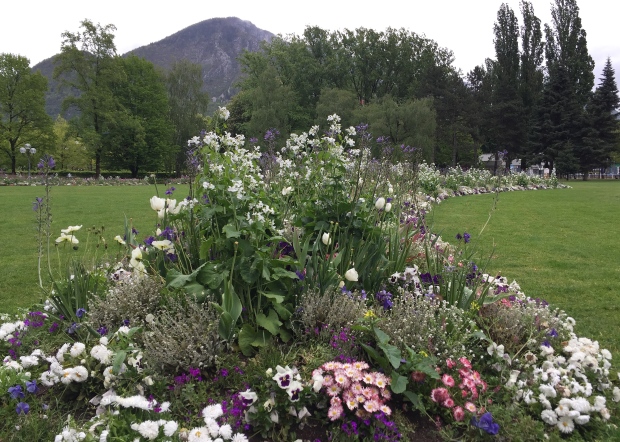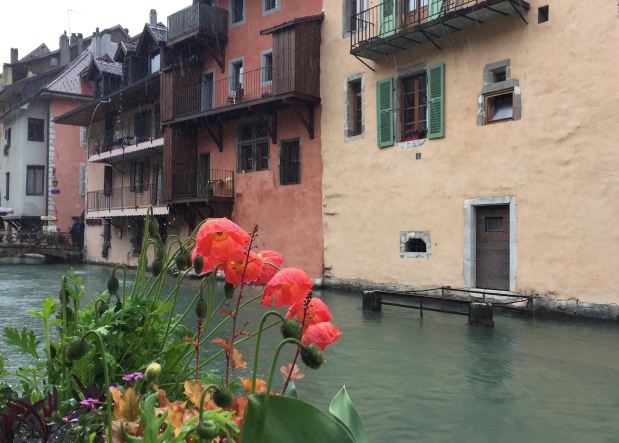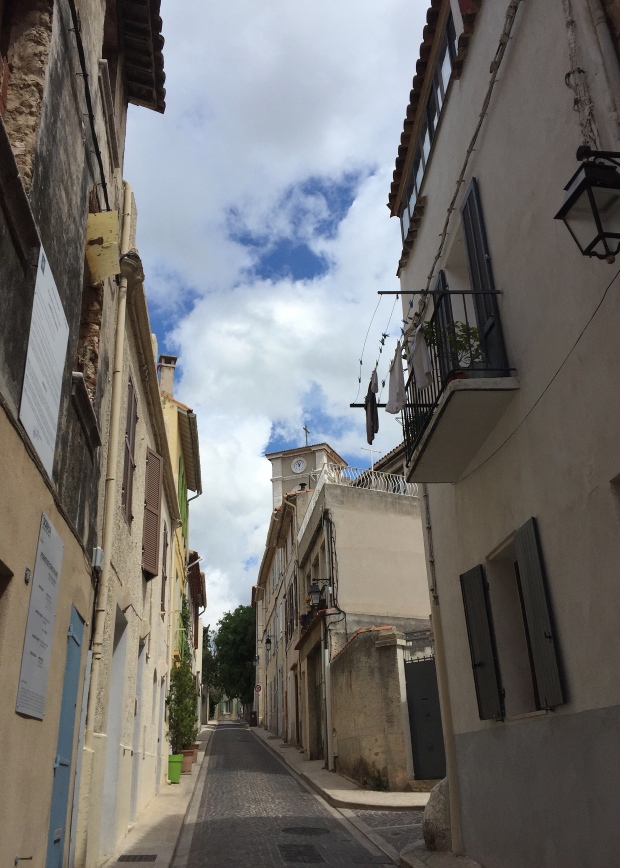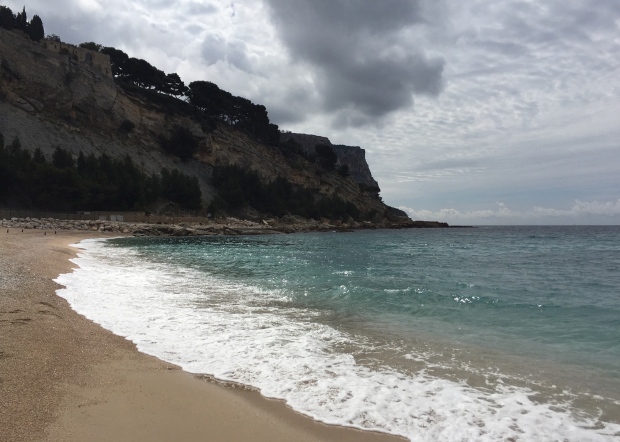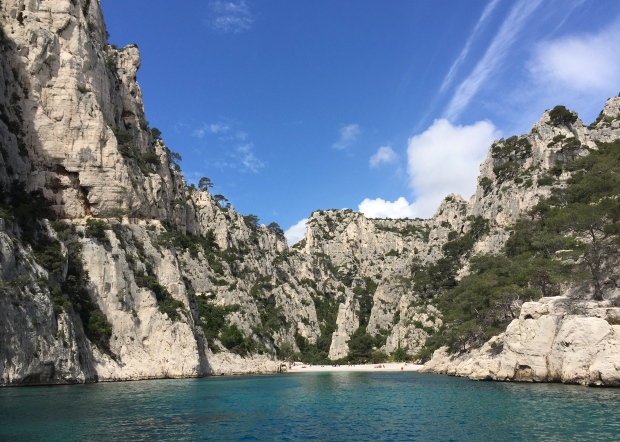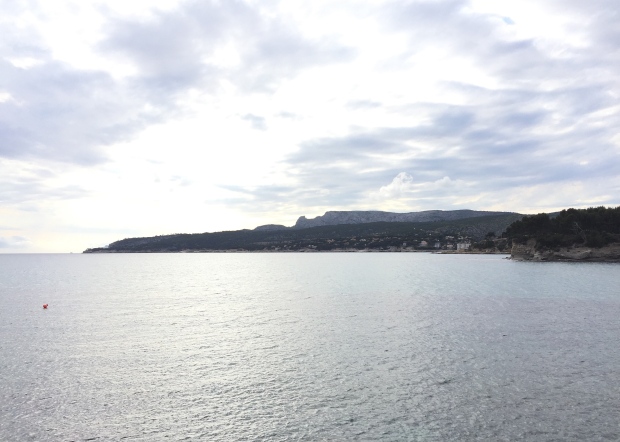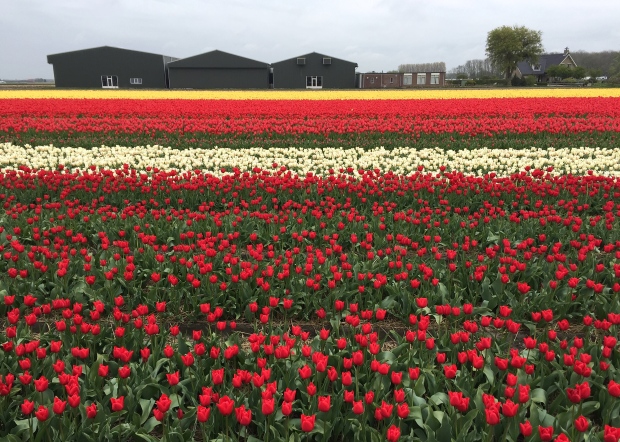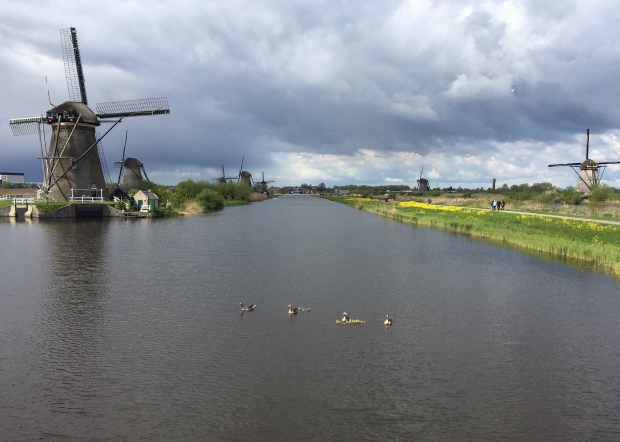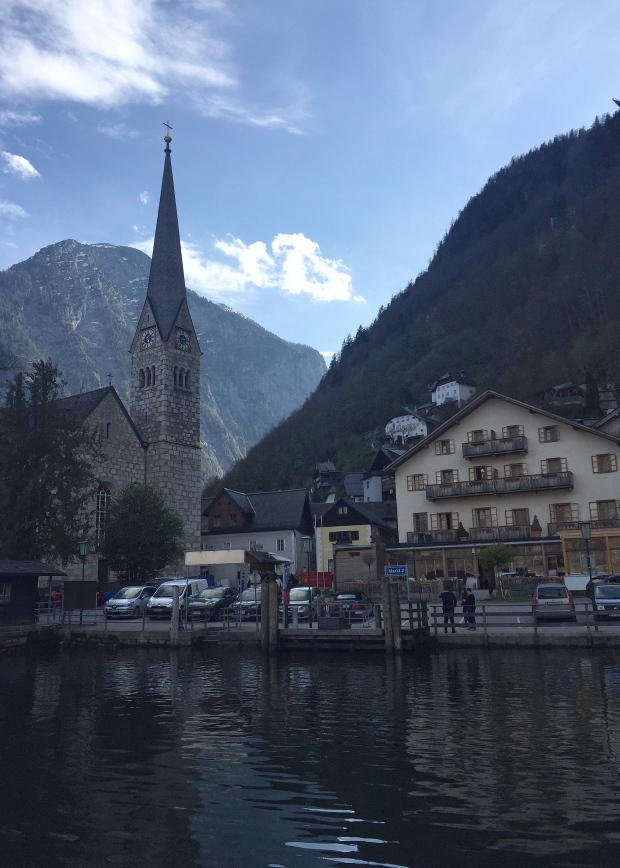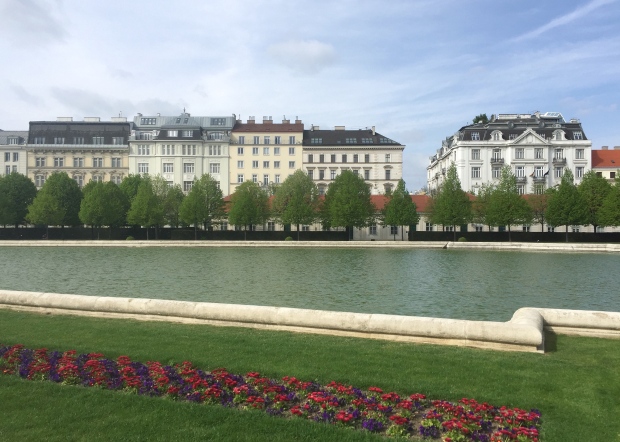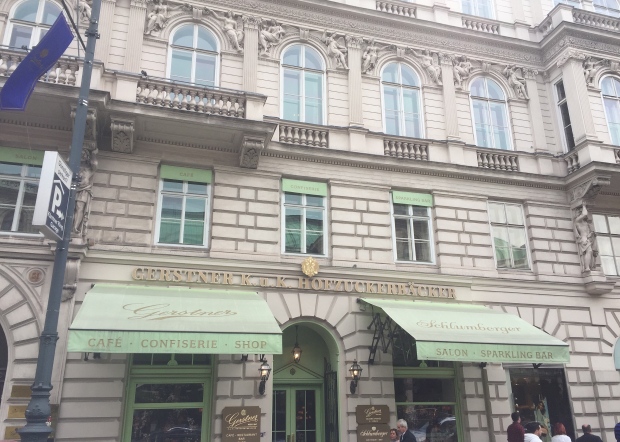Of all of the places I’ve visited, perhaps the one most difficult for me to describe is Berlin. It has an unthinkable history, most notably the horrors that took place during World War II (i.e. the murders committed by the Nazi regime) and the Cold War (i.e. the construction and reinforcement of the Berlin Wall), and so has a striking coldness to it of which I doubt it will ever rid itself. Like many large cities, however, Berlin attracts a diversity of people who, in contrast to the city’s gray past, give it color, made bright by political expression and creativity. From somber memorials to classical architecture and industrial marketplaces to chic nightclubs, Berlin is a city brimming with vibrance that makes it as socially acceptable to dress all in black (and in other, more decidedly weird ensembles) as to graffiti art onto the walls. It is a city that draws energy from its past to define its future. The following are the highlights of my stay.
SIGHTS
Brandenburg Gate
I wanted to see the sunlight shining behind and filtering through the columns, so I arrived in the late afternoon. An information board stated that the gate was modeled on the Propylea of the Acropolis; that the chariot at the top is steered by Victoria, goddess of Victory; that it became a symbol of national unity and freedom in 1806, when Napoleon marched through it; that it was in fact one of 14 original gates and that all but one of the four horses were destroyed during World War II and had to be rebuilt; and that from 1961 to 1989, it was closed off, only to reopen a month after the fall of the Berlin Wall.

Reichstag Dome
If, like me and many other tourists, you haven’t had the foresight to make reservations to visit the dome far enough in advance, you can queue outside the Visitor Information Center across the street to make reservations for dome visits taking place within the next two days. I visited the dome my final morning in Berlin. It wasn’t one of my favorite activities, but it was worth doing.

Gendarmenmarkt
In this beautiful square are located the Französischer Dom, or French Dome; across from it, the Deutscher Dom, or German Dome; and the Konzerthaus, or concert hall. Construction of the two domes was begun in 1701 (the French one was completed in 1705, the German in 1708), and side by side they look like twins. The Französischer Dom was built with the Deutscher Dom at the order of Frederic II for decorative purposes. It’s not itself a church but was given to the French Church in Berlin, founded in 1672 by religious refugees. The Deutscher Dom houses a small German government museum, but all of the information is in German.
When I visited, a musician played down the way from the Französischer Dom and next to an outdoor café, giving a sense of liveliness to the air. On the far side was a beautiful walkway resembling an orchard, with leafy trees at intervals and benches in the shade they cast. In the middle of the square was a white statue that contrasted with the red carpet leading up the steps of the Konzerthaus.



Berliner Dom
I first saw the Berliner Dom, or Berlin Cathedral, from the S-Bahn at dusk and, allured by its prettiness, abandoned my plans to go closer. I saw it from the side, across from the bridge that crosses to Museum Island. Its green roof sparkled through leaves, and it seemed perfectly proportioned, one miniature dome on each corner. When I walked around to the front—over the bridge, through a tree-lined path, and past the Neues Museum—I also thought the Altes Museum very pretty. From the steps of the Berliner Dom, which offer a serene view of the park Lustgarten, it’s to the right and extends the length of the park, which is long. Behind trees at the back of the park, I could see a long pink building, and centered in front of the cathedral was a fountain made of stone resembling slate. Up the steps were two blue and metallic gold mosaics, one a tree with a flower at the top.



MEMORIALS
Berlin Wall Memorial
The history that has taken place in Berlin is truly awful. I think this is from where Berlin drives its austerity, but with the Berlin Wall Memorial, a comprehensive structure, it clearly makes a conscious effort to remember some of that history.
In the Documentation Center are informational boards with blown-up black-and-white photos and years on one side, and narrative, stories, and sometimes, artifacts, on the other. A map showed where the wall intersected 300 streets across the city, and a bar graph indicated the number of people leaving the GDR every year between and including 1951 and 1961. I learned a lot. For example, at a press conference held on June 15, 1961, only two months before the wall was built, GDR leader Walter Ulbricht explicitly said, “No one has any intention of building a wall.” In mid-August, massive protests were held against the construction of the wall, to which the U.S. sent 1,500 soldiers.
Once the wall went up, people struggled to maintain connections from one side of the wall to the other, and many escaped over the wall or died trying. Who made it and who didn’t was somewhat arbitrary: a 17-year-old girl succeeded, but an 18-year-old boy failed. His body was left at the wall for 50 minutes before it was carried away. A cyclist named Harry Seidel was barred from participating in the Olympics but got his wife and baby and 100 other people over the wall. The wall was 12 feet high, there was a patrol, and border soldiers made changes to border fortifications without cease until the wall fell because they could never stop everyone from escaping.

In Area A of the memorial, The Wall and the Death Strip, is a cross for the Sophien Parish and the work it did to build a new cemetery for the graves over which the wall was built, and the Window of Remembrance, a board covered in pictures behind glass of people who died trying to escape over the wall.


In Area B, The Destruction of the City, anecdotes about families torn apart by the wall are written in front of excavated basements of border houses on Bernauer Straße. When these houses were still standing, people escaped over the wall by jumping out of the windows.

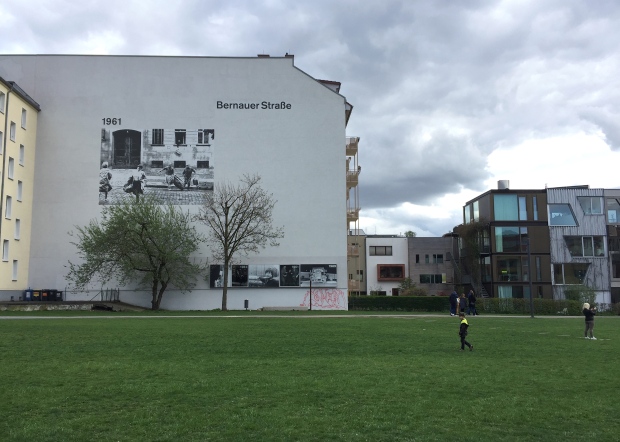
Areas C and D, Building the Wall and Everyday Life at the Wall, contain informative exhibition stations, as do Areas A and B.
Checkpoint Charlie
At the Checkpoint Memorial is a U.S. Army Checkpoint and photos in the air of a Soviet soldier and a U.S. soldier (though I only saw the U.S. one because the Soviet one is on the other side, and I didn’t know this).
East Side Gallery
I wasn’t going to go to the East Side Gallery, because I’m usually not into street art, but enough people I knew had gone that I decided I ought to. It’s very Berlin. Most of the 1316-m-long wall—and this is the original Berlin Wall—has a fence around it because the murals that have been spray-painted onto it are art. One, a tribute to GDR refugees, said “Curriculum Vitae” and listed all of the years for which the wall stood, accented by tiny pink flowers. Another had a red star and American flag. Two doves carried Brandenburg Tor, each holding a string in its beak. Soviet leader Leonid Brezhnev and East German president Erich Honecker kissed, and they kissed again in varying colors above a Checkpoint Charlie caricature.



Memorial to the Sinti and Roma Victims of National Socialism
Walking through the trees behind Brandenburg Gate towards the garden (which is lovely, particularly the walk alongside the memorial coming from Potsdamer Platz), I ran into what I thought was the Memorial to the Murdered Jews of Europe but was actually the Memorial to the Sinti and Roma Victims of National Socialism, a pool of water reflecting the sky, through frosted glass on which was a chronological history of the genocide.

Memorial to the Murdered Jews of Europe
The Memorial to the Murdered Jews of Europe is 2,700 stelae of varying heights, arranged in rows. Walking through the rows was unsettling. The light so far away at the other end, they seemed endless. I saw stairs but didn’t realize that they led to the Information Center. It would seem obvious that of course, like the Berlin Wall Memorial, the Memorial to the Murdered Jews of Europe would have an information center, but I wasn’t focused. I regret not descending the stairs to the Rooms of Names, Families, Sites, Dimensions.

SHOPPING
April First
This pretty little boutique sells candles, sweaters in soft pink, and tops and dresses in sweet but unconventional silhouettes.
Bikini Berlin
This concept shopping mall in the City West district, the largest shopping district in Berlin, is made unique by its wooden “pop-up boxes,” like oversized kiosks, and origami art to which shoppers can add that looks like a garden, though shapes also hang from the ceiling.
FOOD
Markthalle Neun
Every Thursday night from five to ten, this indoor market hall is packed with people come to enjoy the drinks and international food of Street Food Thursday. The complex has an industrial vibe, with strings of lights, tucked-away tables, and a wooden staircase to nowhere for diners to sit on. From a “natural wine” stand near the front I took a glass of Tardana Orange, a Spanish wine, after tasting a French wine to which I was initially drawn for its transparent purple color but that tasted like flowers. Unfortunately, by the time I arrived, a Japanese bakery and a Vietnamese dumpling stand were both nearly out, so the only food I tried was a vegetarian hummus burrito, but that was yummy.


Distrikt Coffee
This warm coffee and brunch hotspot with wooden tables and copper accents makes an iced flat white, which I’d never seen on a menu, served in a trendy mini mason jar. I didn’t order food, but the plates I saw on other sides of the table at which I sat—the tables are communal—looked delicious.
Hallesches Haus
Bouquets of fresh flowers sit atop every table, and the coffee shop makes scrumptious French toast with whipped cream, strawberries, and pistachios.
Kauf Dich Glücklich
This quirky little café and ice cream parlor was recommended to me by a friend who is from Berlin. As it turns out, it’s a chain, and many of its stores also function as clothing boutiques. This one doesn’t, but the lettering of the sign is the same: individual letters in squares, looking like they’ve been cut out of magazines. I was told that the waffles are excellent, but from across the room, I saw someone with something that looked delicious and so ordered that. The menus were all in German, so I wish I had taken a picture of one so I would remember what I ordered was called, but it was essentially a breakfast parfait with a thick vanilla-yogurt-like ingredient (quark?), strawberry sauce, muesli, and fruit—still dessert, but lighter than a waffle.

Zeit für Brot
The name of this bakery translates to “Time for Bread,” and its cinnamon rolls are fluffy and perfect, the best I’ve had. The whole place smells of cinnamon!
Rose Garden
This airy café is popular for breakfast and lunch. It has a small coffee bar and drinks refrigerator full of coconut waters and fizzy drinks, and it offers many healthy menu options (I recommend the matcha latté and avocado hummus, not together). Its design is intelligent, too: the room nearest the windows is made to look larger than it is by mirrors on the far wall, lights hanging from the ceiling lend the café a romantic feel at night, a high table on the other side is perfect for writing, if you’re into that sort of thing, and another room is hidden in the back.
Si An
I’d read that many Vietnamese people live in Berlin and so there are a lot of Vietnamese restaurants. For dinner my last night in Berlin, I went to a highly rated one called Si An. It was easily the most beautiful restaurant, Vietnamese or otherwise, I’ve ever been to. Lanterns hanging outside made the restaurant visible from the end of the block; up close, they were finely textured like threads crisscrossing on a spool, in varying natural colors. The name of the restaurant was carved in calligraphy onto a stone tablet mounted on the wall. Inside, eggplant-colored fabric cranes hung from the ceiling, and the biggest pink lilies and pale yellow peonies that looked as though they would smell of good dreams tumbled over the sides of a clay vase set into the corner. Tealight candles and small yellow and lavender flowers floated in pots of water along the walls. The air was warm with incense. I ordered the Pho Bo and café noir—Vietnamese coffee dripped through a French-press-like filter onto condensed milk.



CLUBS
House of Weekend
I was poised to floss, the string wrapped around my fingers, when the American who was sleeping on the bunk below mine and her two friends invited me to come to House of Weekend with them and some other Americans. It was a Thursday and my first night in Berlin, and though I desperately needed sleep, having slept only four hours the past two nights, I had read about this place and saw this as my opportunity to go—for a solo female traveler, opportunities to go out are few and far between. So I went, and though the small nightclub, to my disappointment, played American songs the entire night instead of the techno and deep house for which it’s known, it had two floors, paper lanterns for décor, and a rooftop garden, from which I was able to look out at Berlin in the cool night air.
GRACE Berlin
This is by far the classiest bar to which I’ve been. I went with my German friend and her boyfriend, and we had to walk around to the back of the hotel of which it’s a part and ring to go in! Past the coat check and down the hall was a royal purple velvet couch that wrapped around the wall and tables and cushions perfect for two. The drinks, especially one made with lavender flowers and champagne, cost a small fortune, so I found happiness sipping on a virgin elderflower tonic and trying to figure out what other people had ordered. At first the music was relaxing, but not long after we arrived, it changed to club music, and on our way out, we saw that a DJ was actually playing! Particularly telling, I think, was the fact that the hand towels in the bathroom were washcloths.
 While photos have the ability to make almost anything look beautiful, the corollary is that there is beauty to be found in most everything.
While photos have the ability to make almost anything look beautiful, the corollary is that there is beauty to be found in most everything. 


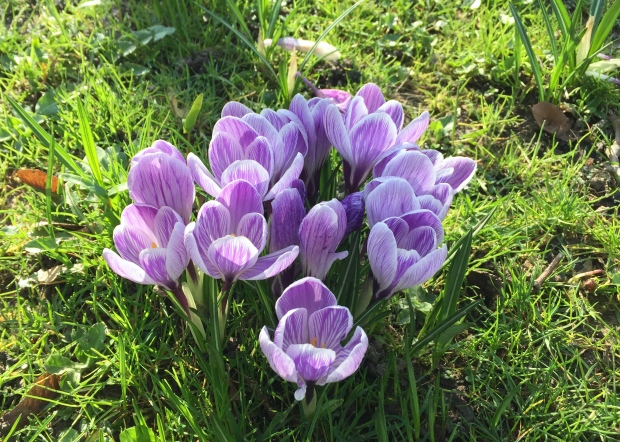





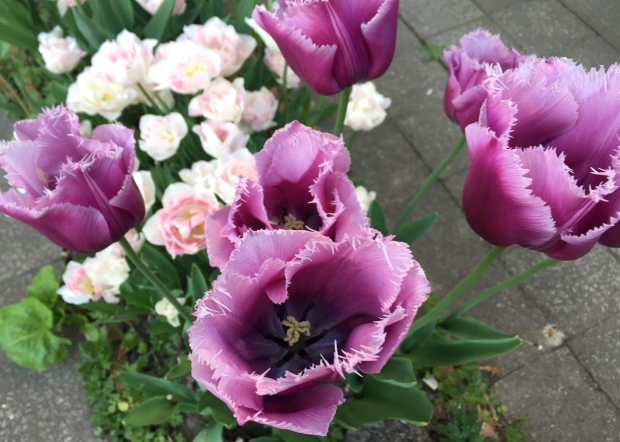


 Only the bravest of cherry trees near the Petit Palais had blossomed. The Grand Palais, however, had opened a temporary exhibition called, appositely, “Jardins,” which I adored: analog photography and silver bromide gelatin prints, cut paper, watercolors of crumpled irises with edges like eyelash lace. My favorite work was one of two botanical drawings from Conrad Gessner, Orlaya grandiflora, a sketch of the white lace flower from between 1555 and 1565.
Only the bravest of cherry trees near the Petit Palais had blossomed. The Grand Palais, however, had opened a temporary exhibition called, appositely, “Jardins,” which I adored: analog photography and silver bromide gelatin prints, cut paper, watercolors of crumpled irises with edges like eyelash lace. My favorite work was one of two botanical drawings from Conrad Gessner, Orlaya grandiflora, a sketch of the white lace flower from between 1555 and 1565.




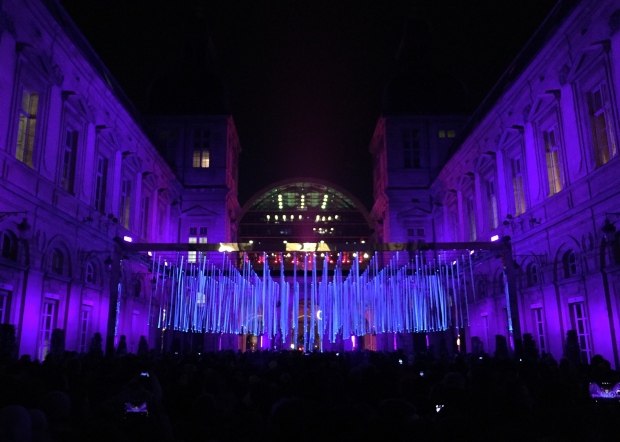 Through the opposite side of the courtyard was Place des Terraux, where on the facades of Hôtel de Ville and the adjacent Musée des Beaux-Arts played “
Through the opposite side of the courtyard was Place des Terraux, where on the facades of Hôtel de Ville and the adjacent Musée des Beaux-Arts played “ A bridge spanning one of Lyon’s two rivers had been transformed into “Bright Boat,” swirls of white light from which blue spotlights rotated in small circles, as oars paddling, while across the river Saône, at the base of Fourvière Hill, “Soleil” evoked the natural progression of the sun from sunset to dawn, sparkling at midnight as the Eiffel Tower sparkles on the hour.
A bridge spanning one of Lyon’s two rivers had been transformed into “Bright Boat,” swirls of white light from which blue spotlights rotated in small circles, as oars paddling, while across the river Saône, at the base of Fourvière Hill, “Soleil” evoked the natural progression of the sun from sunset to dawn, sparkling at midnight as the Eiffel Tower sparkles on the hour.

 Place de la Bourse was a winter garden filled with my favorite flower—peonies, or “Les Pivoines”—and at Place des Célestins, “Coups de Cœur” was a heart beating in time with the combined pulses of couples who went on stage and kissed.
Place de la Bourse was a winter garden filled with my favorite flower—peonies, or “Les Pivoines”—and at Place des Célestins, “Coups de Cœur” was a heart beating in time with the combined pulses of couples who went on stage and kissed.

 The jewel of the festival was the Ferris wheel at Place Bellecour, onto which a short animation, “Un songe forain,” or “A Fairgrounds Dream,” explored themes reminiscent of those on which I wrote papers in school—fairy tales, sexual death. I watched it both nights.
The jewel of the festival was the Ferris wheel at Place Bellecour, onto which a short animation, “Un songe forain,” or “A Fairgrounds Dream,” explored themes reminiscent of those on which I wrote papers in school—fairy tales, sexual death. I watched it both nights. Before nightfall the second night, my friend and I went to the Marché du Noël in Place Carnot, where we crowded into the prettiest vin chaud stand and looked on as the trees of the Forêt des Lumières, not a part of the festival but illuminated all the same, changed colors.
Before nightfall the second night, my friend and I went to the Marché du Noël in Place Carnot, where we crowded into the prettiest vin chaud stand and looked on as the trees of the Forêt des Lumières, not a part of the festival but illuminated all the same, changed colors.
 Once it was dark, we walked down to Confluences, which as anyone who has visited Lyon will know is removed from the rest of the city. Along the way we saw “Caprice” on the water. The reason for our trek was “Deep Web,” a light show set to trance-like music wherein LED orbs suspended from wires moved like caterpillars in red, pink, and blue-violet oscillations and promised new formations that wanted to be stars but weren’t until finally they were, white and shimmering.
Once it was dark, we walked down to Confluences, which as anyone who has visited Lyon will know is removed from the rest of the city. Along the way we saw “Caprice” on the water. The reason for our trek was “Deep Web,” a light show set to trance-like music wherein LED orbs suspended from wires moved like caterpillars in red, pink, and blue-violet oscillations and promised new formations that wanted to be stars but weren’t until finally they were, white and shimmering.
 The most technically impressive show was our last: “Evolutions,” projected onto the Saint-Jean cathedral. It matched perfectly every pane of every window and even a small clock to one side, reimagining the cathedral’s construction, first in paper and then in silk, steel, light, and energy.
The most technically impressive show was our last: “Evolutions,” projected onto the Saint-Jean cathedral. It matched perfectly every pane of every window and even a small clock to one side, reimagining the cathedral’s construction, first in paper and then in silk, steel, light, and energy.  I immediately thought of this when I watched the light show projected onto the Freer Gallery of Art, “Perfect Harmony” (created by 59 Productions, which designed the opening ceremony for the London 2012 Olympic Games), at IlluminAsia, a festival celebrating the reopening of the Freer|Sackler Galleries (Smithsonians that house Asian art). The light there similarly fit all of the details of the building, telling first the story of Charles Lang Freer’s collection of art coming to America and then celebrating that art in a classical number full of twinkling in time with notes and dancing in red, white, and blue. It even incorporated those details into the third story it told, that of the building’s creation to serve as a home for the art: Asian characters ran across the top of the building as steel and stone gave it shape until finally, script of many languages flashed across the center of the facade, followed by “THINK FREER” diagonally and then, simply, “Freer|Sackler.”
I immediately thought of this when I watched the light show projected onto the Freer Gallery of Art, “Perfect Harmony” (created by 59 Productions, which designed the opening ceremony for the London 2012 Olympic Games), at IlluminAsia, a festival celebrating the reopening of the Freer|Sackler Galleries (Smithsonians that house Asian art). The light there similarly fit all of the details of the building, telling first the story of Charles Lang Freer’s collection of art coming to America and then celebrating that art in a classical number full of twinkling in time with notes and dancing in red, white, and blue. It even incorporated those details into the third story it told, that of the building’s creation to serve as a home for the art: Asian characters ran across the top of the building as steel and stone gave it shape until finally, script of many languages flashed across the center of the facade, followed by “THINK FREER” diagonally and then, simply, “Freer|Sackler.”




